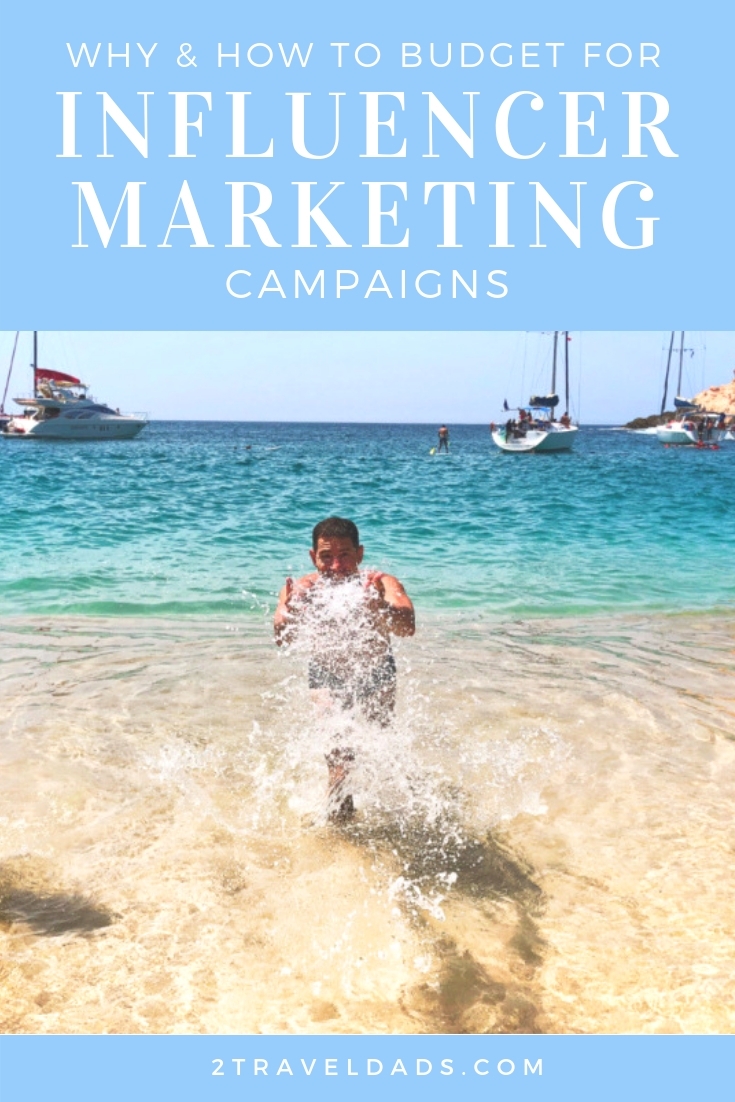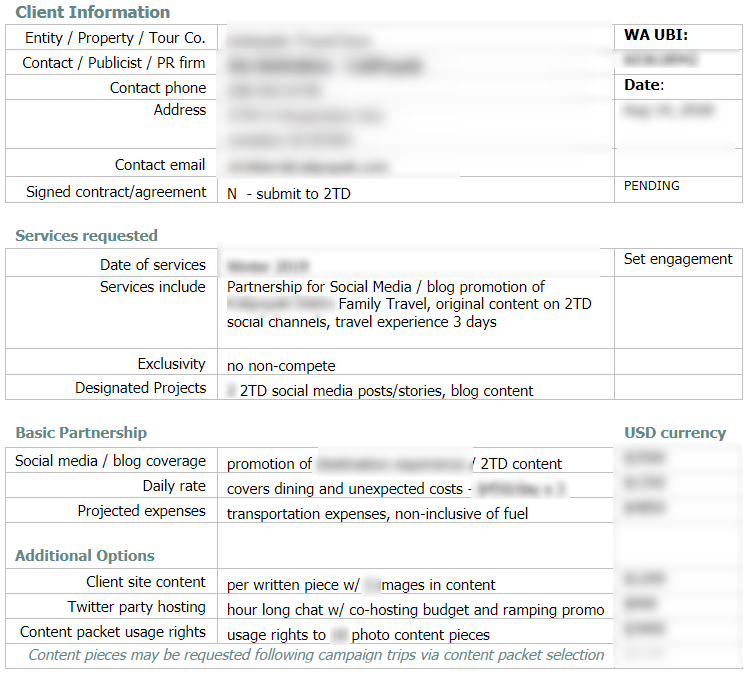This is part two of our series on Building Blogger and Influencer Marketing Partnerships. In part one we explained what an “influencer” is and in part two we’re going to talk about how to budget for influencer marketing campaigns.
The first thing we hear from many PR reps and marketing teams is that “we don’t have a budget for X,Y, or Z.” Actually you do, you just need to know how to relate value to an influencer partnership. Once you can associate value with a blogger, you’ll see why it’s important to find or allocate a budget for influencer marketing.

Why do we need a budget for Influencer Marketing?
Nobody likes to talk about money and paying for something they don’t understand, but I’ll make this simple and embraceable. Just like a business has a budget to advertise on a billboard or local television, on the back of a grocery store receipt or in the regional newspaper, a business has the option to create a budget for influencer marketing. Yes, it has a cost. No, you should not expect people to work for free or do your advertising for you as a favor.
Let’s make that clear:
At a time where wages and equal pay are at the forefront of conversation, nobody should be working for free. Skilled labor of any kind has value, and just like you wouldn’t invite somebody into your business to install new plumbing features for free, you wouldn’t ask somebody else to work for free.
Product is not pay
“But if I’m giving an influencer my product, why would I need to pay them? The product is pay.” No, that’s not true and this is why creating a budget for influencer marketing is important. The product is a tool an influencer needs to be able to do the rest of their job.
Would you not pay that same plumber noted above because you had the new faucet for your bathroom or your own tool belt already so they didn’t have to buy one on their own? No. Skilled work is skilled work and budgeting for marketing, no matter your current business plan, is an important need to consider.
Understanding influencer content
“But they’re bloggers. Bloggers just word-vomit and post to Instagram.” Um, no. While there are bloggers and influencers who do distribute opinions and pictures like it’s going out of style, those messages are thought out and highly applicable to their following. Those bloggers are influencing using their acquired skills and network.
Bloggers and influencers that give off a more polished final product in their platform streams just have a different method to crafting their content. Both are doing work, just in a different style and maybe to a different audience/value point. More on that below…
Note: when I say “more polished” I only mean that the perception is more polished. It might be that one blogger is rough and edgy while another is very manicured and fits a certain visual style. Both are deliberate in their work.
Influencer content, whether part of a paid campaign that stems from a budget for influencer marketing or something a blogger has created from their own branded plan, has three characteristics:
- Intention – there is a message being communicated to influence or trigger a thought process
- Appeal – honey or vinegar, when an influencer releases content they’ve made sure it’s going to draw their following in
- Actionable – even if not blatantly stated, every piece of blogger/influencer content is a call to action
The best influencer content hits these three points and comes from their authentic voice or point of view (POV). When you engage an influencer to join in a campaign plan, you’re asking them to take your goals and translate them into content messaging that appeals to their audience in hopes that they’ll click through (CTR) to your product or begin long term planning.
An influencer that believes in the product/campaign they’re working on will be successful in crafting and distributing valuable content… the reason you’re hiring them.
Realistic Expectations of an Influencer Marketing Campaign
Bringing on a blogger or influencer isn’t hiring a wizard. It’s hiring somebody to create an share meaningful content that INFLUENCES people to take action towards YOUR PRODUCT… It is not hiring somebody to reach a minimum number of people that will drop $5k on your business that same day. What you should expect:
- skillfully crafted content reflecting your preferred messaging OR what the influencer sees is the driving message
- content output matching your agreed upon deliverables
- transparency in reporting back to you based on what your agreement says they’ll share*
- *if you would like full in depth reporting from a campaign and expect a complete presentation including an ROI analysis, you need to put that into the contract. If a blogger/influencer chooses to provide that to you on their own, great, but do not expect it if you haven’t stated so in advance
Something that is key to remember when you’re setting up a budget for an influencer marketing campaign and designing a plan, is that ultimately the individual you hire isn’t in control of who sees their content. If you’re looking for a thousand “swipe ups” on Instagram or a gazillion click-throughs to your website, no one can guarantee that. The algorithms determine who sees what on social media.
Smartest content to budget for: EVERGREEN BLOG CONTENT
It’s true that the algorithms determine who sees what, and that includes Google and how they choose to place a blogger’s content. A good blogger will be taking a holistic approach to creating content though, so budgeting for a campaign that’s all about a full suite of content in the way to go.
If you want to see long term success from an influencer campaign, the key is getting solid blog content that will live for longer than an Instagram post. Ideally, a blogger will be sharing their blog content to their various social channels, and if YOUR product is great and inspiring to them, they’ll over-deliver on your set expectations of output…
…and long after your campaign they will still have content on their blog that refers people to you and that they’ve lent their credibility and authority to. It’s the best investment to consider when you’re building an budget for influencer marketing.
What should I budget for Influencer Marketing costs?
Let’s keep it simple and outline the actual costs for working with an influencer. Any plan to contract any third party for work at any time, whether it’s that plumber from before or a blogger on a campaign, should include the following:
- Cost of supplies/product
- Compensation for time & labor
- Cost of any premium service
Note: not every contractor provides an invoice right off the bat with their costs fully broken down, but within a bid or final invoice, this information should be available in one form or another. There’s no harm in asking for a breakdown of cost data.
This basic structure is the same when working with contractors or influencers. Business-wise, the cost center may be different, either falling within the Marketing/Advertising budget, a Consulting budget or even the Travel & Entertainment budget. In some cases your business may need to separate the overall cost of an influencer marketing campaign to hit a variety of cost centers, but where there’s a will there’s a way.
And on some level, there’s nearly always some sort of budget for it, even if it falls into the next quarter of fiscal year (FY).
An example of how to distribute costs within the budget for influencer marketing could work as follows for different sorts of businesses:
- Required product – inventory markout (goods), comp room night (travel), labor hours (personal experience)
- Influencer Time & Labor – consulting or professional fees *inquire w/ accountant
- Services / Campaign deliverables – marketing and advertising budget
- Hosting an experience – including cost of transportation, falls to a Travel & Entertainment (T&E) budget
Each of these budget buckets can work together to create a feasible campaign plan that both funds the work and the distribution of content. Did you realize that you already have the framework to budget for influencer marketing? It’s true! You’re already on your way to a successful campaign!
Influencer Marketing: compensation rates
Eggshells: consider them crushed right now because I’m going to jaunt across them now. Since we’ve established that nobody should be working for free, here’s how to determine or justify compensation rates when creating a budget for influencer marketing.
Keep in mind that all influencers have different reaches, different levels of engagement and commitment, and they all use different tools to do their jobs. This diversity of working methods and skills warrants different compensation for different influencers.
And let’s call this out right away: if two influencers have the exact same skills, same reach, same metrics, same everything but just different brands, they should be paid the same no matter their gender. If an influencer has a different audience demographic that statistically has a greater spend or CTR, that warrants a greater investment in the influencer marketing campaign.
Oh, you want to know what it actually costs to hire somebody for an influencer marketing campaign? You need to inquire with each individual. Everybody manages their business differently and assuming that each blogger is going to be aligned in rates is like assuming that every beach is going to have dolphins swimming in the surf.
Our bid form looks like this, but with clear notations about anything that may or may not already have been discussed with the potential client. It’s rare that we do a campaign that is just one lump sum quote, as experiences and flexibility can really vary.

You should expect the following when requesting a bid for work from a blogger or influencer; format may vary.
Bid that outlines what the blogger or influencer is being engaged for:
- statement of services and projected influencer channels – what content distribution is requested
- scope of work (SOW) or previously discussed projects – is the primary work written, video, event engagement
- exclusivity – depending on the client, exclusivity may be important and an influencer may require a premium to enter into exclusivity
Line items of required costs applicable to the influencer marketing campaign**:
- breakdown of content costs – blogger/influencer is creating content which is a “product” being purchased
- daily rate – this applies to influencer marketing campaigns that require attendance or travel
- projected expenses – this may include transportation costs, per diem, any tangible goods needed for specific activation/project
- **some bloggers and influencers may just present a lump sum cost when a rate/bid is requested. If you feel like you need to justify the total, ask for a breakdown. If they don’t want to break it down, that’s up to them, and up to you if you choose to more forward or not.
Additional Services
Additional options may be noted on a bid. Isn’t the first rule of salesmanship and growing a business to ask for the sale? Blogs and media outlets are businesses creating and distributing products.
From my own experience I know that asking for the sale and offering additional services or products has great returns. We’ve been able to run online marketing campaigns with advertising dollars behind them because we’ve suggested it. We’ve crafted content specifically for clients in addition to the initial campaign because we’ve suggested it following a successful influencer marketing engagement. We are sure to inform clients that our photographic and video work may also be licensed.
The additional services a blogger may offer might be very useful for clients. When a bid is returned and there are suggestions, think of it as an up-sale at the grocery store: you didn’t know that you needed a tin of mints, but now that you see them you realize that you could use some help with your breath.
This should be quite helpful in understanding how to budget for influencer marketing and what to expect as you engage a blogger or influencer to use their voice and network to your advantage. Like with any successful project, keep the conversation going, whether that be around budget or on content deliverables. Collaborating and setting clear expectations with each other will make any campaign feel like a team effort and will naturally drive great content and results.


